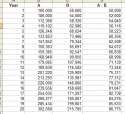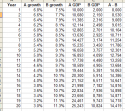plawolf
Lieutenant General
Both sides seems to be cherry picking maths a little here.
Assuming we accept the very dodgy Indian 7.75% growth figure for the sake of argument. It means that compared to China's 6.33% growth, India's economy is growing faster.
However, because of China's vastly larger base economy size, at 11,211bn, China would have grown by 709.72bn for the year verses India's 178.87bn growth.
China's economy grew by more, but India's grew faster.
So technically, India is catching up with China. But only at a snail's pace.
If those growth rates were locked in, it would take 120 years for India's economy to be bigger than China's.
By 2020, India would have gone from 20.59% of China's GDP to 22%. If India wants to throw a dance party about that, well, be my guest.
But the giant problem with all of this is trying to draw such grandiose trend assumptions from such pitiful evidence.
The only thing anyone could reasonable conclude from so little data is not the underlying economic performance being discussed, but rather the prejudices of the people seeking to draw conclusions from nothing.
It should also be noted that military might lags behind GDP, because military power is accumulated cumulatively through a long period of time.
Case in point, China is projected to have a bigger economy than America's in as little as 5 years' time, but by no estimate would Chinese military power approach parity with America's for many decades beyond that point.
To keep comparing India to China is to do both a grave disservice.
For China, it's disrespectful to be compared to such an economic and technological minnow as if the two were equals.
For India, it's complacent to be implicitly elevated to a position far beyond what they have achieved and earned, thereby deflating a great deal of the near panic levels of urgency and a drive to catch up that Indians should be feeling about how far ahead China has pulled.
One of the key reasons to China's success is precisely because the entire Chinese civilisation felt such an overwhelming sense of urgency and drive to catch up because of how far they were behind the west.
Indians seems to keep expecting someone to hand them their 'rightful place' on a silver platter with a pretty pink bow on top without them having to do any actual work to earn it.
Chinese are desperately fighting and scraping to get to where they think they should be, and are secretly terrified that if they don't give 110%, they might fall short of their goal.
The daydreamer may get handed everything he ever dreamed or, and the scrapper may still fall short, such is life. But the smart money is on the scrapper.
Assuming we accept the very dodgy Indian 7.75% growth figure for the sake of argument. It means that compared to China's 6.33% growth, India's economy is growing faster.
However, because of China's vastly larger base economy size, at 11,211bn, China would have grown by 709.72bn for the year verses India's 178.87bn growth.
China's economy grew by more, but India's grew faster.
So technically, India is catching up with China. But only at a snail's pace.
If those growth rates were locked in, it would take 120 years for India's economy to be bigger than China's.
By 2020, India would have gone from 20.59% of China's GDP to 22%. If India wants to throw a dance party about that, well, be my guest.
But the giant problem with all of this is trying to draw such grandiose trend assumptions from such pitiful evidence.
The only thing anyone could reasonable conclude from so little data is not the underlying economic performance being discussed, but rather the prejudices of the people seeking to draw conclusions from nothing.
It should also be noted that military might lags behind GDP, because military power is accumulated cumulatively through a long period of time.
Case in point, China is projected to have a bigger economy than America's in as little as 5 years' time, but by no estimate would Chinese military power approach parity with America's for many decades beyond that point.
To keep comparing India to China is to do both a grave disservice.
For China, it's disrespectful to be compared to such an economic and technological minnow as if the two were equals.
For India, it's complacent to be implicitly elevated to a position far beyond what they have achieved and earned, thereby deflating a great deal of the near panic levels of urgency and a drive to catch up that Indians should be feeling about how far ahead China has pulled.
One of the key reasons to China's success is precisely because the entire Chinese civilisation felt such an overwhelming sense of urgency and drive to catch up because of how far they were behind the west.
Indians seems to keep expecting someone to hand them their 'rightful place' on a silver platter with a pretty pink bow on top without them having to do any actual work to earn it.
Chinese are desperately fighting and scraping to get to where they think they should be, and are secretly terrified that if they don't give 110%, they might fall short of their goal.
The daydreamer may get handed everything he ever dreamed or, and the scrapper may still fall short, such is life. But the smart money is on the scrapper.


